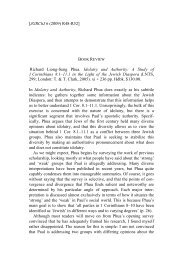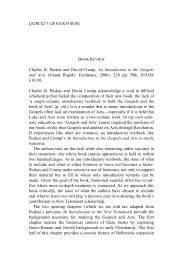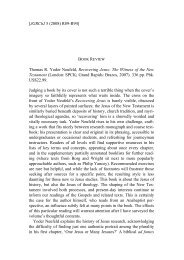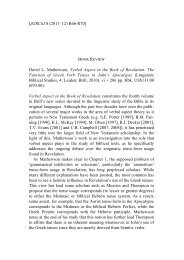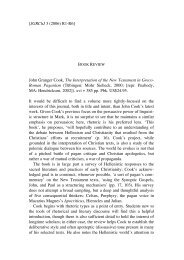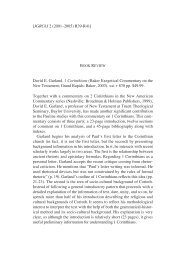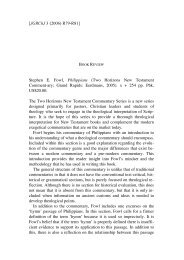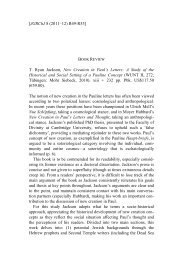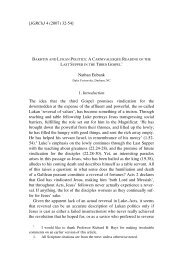Jae Hyun Lee, Paul's Gospel in Romans - Journal of Greco-Roman ...
Jae Hyun Lee, Paul's Gospel in Romans - Journal of Greco-Roman ...
Jae Hyun Lee, Paul's Gospel in Romans - Journal of Greco-Roman ...
Create successful ePaper yourself
Turn your PDF publications into a flip-book with our unique Google optimized e-Paper software.
R151 <strong>Journal</strong> <strong>of</strong> <strong>Greco</strong>-<strong>Roman</strong> Christianity and Judaism 8<br />
In the subsequent chapters, <strong>Lee</strong> demonstrates that Paul uses two descriptive<br />
frameworks to express the gospel <strong>of</strong> salvation: ‘(1) an <strong>in</strong>teractive<br />
framework between God and humans; and (2) a contrast between<br />
the old realm and the new’ (p. 431). Here is the content <strong>of</strong> Paul’s gospel:<br />
salvation <strong>in</strong> the <strong>in</strong>teractive framework is expressed as God’s<br />
reward-gift to people who have faith; and <strong>in</strong> the two-realm framework<br />
it relates to the transition <strong>of</strong> believers from the old realm (under the<br />
power <strong>of</strong> s<strong>in</strong>, death, etc.) to the alternative new one (union with God’s<br />
grace and eternal life). Chapter 3 deals with Rom. 1.16-17, which<br />
serves as an <strong>in</strong>troduction to Paul’s gospel as salvation to all believers.<br />
The next two chapters are about the <strong>in</strong>teractive paradigm between human<br />
s<strong>in</strong>fulness and God’s wrathful judgment throughout Rom. 1.18–<br />
3.20. Chapter 6 shows a new salvific <strong>in</strong>teractive paradigm <strong>in</strong> Rom.<br />
3.21–4.25, which focuses on ‘the <strong>in</strong>teraction between human faith and<br />
God’s gracious salvation’ (p. 213) <strong>in</strong> the forensic dimension.<br />
Chapter 7 discusses the fact that Jesus holds the central role <strong>in</strong> <strong><strong>Roman</strong>s</strong><br />
5, which not only <strong>in</strong>cludes the previous topical issues, but also<br />
provides a more complete picture <strong>of</strong> salvation than before. It adds a relational<br />
dimension, an aspect <strong>of</strong> the future state, and <strong>in</strong>troduces a tworealm<br />
framework <strong>in</strong> describ<strong>in</strong>g salvation <strong>in</strong> which believers are transferred<br />
from the dom<strong>in</strong>ion <strong>of</strong> s<strong>in</strong> and death to the new realm <strong>of</strong> God’s<br />
grace.<br />
In Chapter 8, <strong>Lee</strong> argues that <strong>in</strong> Rom. 6.1–7.25 Paul describes the<br />
two contrast<strong>in</strong>g realms <strong>of</strong> a believer’s life. The first unit, Rom. 6.1–7.6,<br />
focuses on the believer’s new life <strong>in</strong> the realm <strong>of</strong> eternal life. In the<br />
second unit, Rom. 7.7-25, Paul shows ‘the seriousness <strong>of</strong> s<strong>in</strong> <strong>in</strong> human<br />
life…through the depiction <strong>of</strong> a tragic situation <strong>of</strong> the unregenerate person<br />
<strong>in</strong> Rom. 7.7-25’ (p. 378). In Chapter 9, <strong>Lee</strong> <strong>in</strong>dicates that Rom.<br />
8.1-39 gives a supplementary view on God’s salvific works <strong>in</strong> which<br />
Paul provides a detailed explanation about the role <strong>of</strong> the Spirit <strong>in</strong> respect<br />
to the life <strong>of</strong> believers.<br />
In the last chapter, <strong>Lee</strong> concludes that Paul’s gospel about God’s salvation<br />
has one peak po<strong>in</strong>t <strong>in</strong> <strong><strong>Roman</strong>s</strong> 5 and two sub-peaks <strong>in</strong> Rom.<br />
3.21-26 and <strong><strong>Roman</strong>s</strong> 8, respectively. Appendices 1 and 2 are related to<br />
the analysis <strong>of</strong> Rom. 1.16–8.39 accord<strong>in</strong>g to the frame <strong>of</strong> topicality and<br />
semantic doma<strong>in</strong>s, respectively.<br />
This book makes a great contribution to biblical studies <strong>in</strong> terms <strong>of</strong> a<br />
l<strong>in</strong>guistic discourse approach. S<strong>in</strong>ce not many New Testament texts<br />
have been considered from this perspective, such a methodology will



